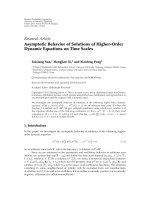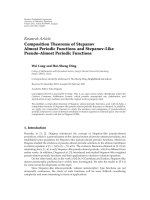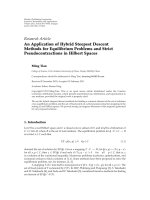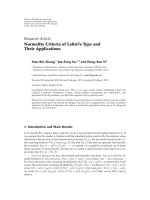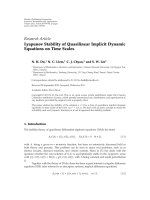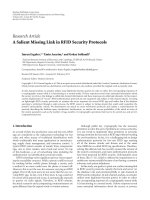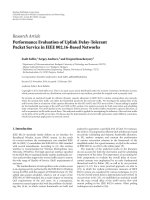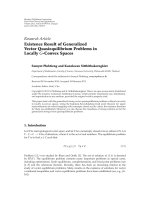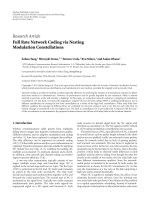Báo cáo hóa học: " Research Article Improved Design of Unequal Error Protection LDPC Codes" pot
Bạn đang xem bản rút gọn của tài liệu. Xem và tải ngay bản đầy đủ của tài liệu tại đây (816.16 KB, 8 trang )
Hindawi Publishing Corporation
EURASIP Journal on Wireless Communications and Networking
Volume 2010, Article ID 423989, 8 pages
doi:10.1155/2010/423989
Research Article
Improv ed Design of Unequal Error Protection LDPC Codes
Sara Sandberg
Department of Computer Science and Electrical Engineering, Lule
˚
a University of Technology, SE-971 87 Lule
˚
a, Sweden
Correspondence should be addressed to Sara Sandberg,
Received 7 September 2010; Accepted 9 November 2010
Academic Editor: Richard Kozick
Copyright © 2010 Sara Sandberg. This is an open access ar ticle distr ibuted under the Creative Commons Attribution License,
which permits unrestricted use, distribution, and reproduction in any medium, provided the original work is properly cited.
We propose an improved method for designing unequal error protection (UEP) low-density parity-check (LDPC) codes. The
method is based on density evolution. The degree distribution with the best UEP properties is found, under the constraint that
the threshold should not exceed the threshold of a non-UEP code plus some threshold offset. For different codeword lengths and
different construction algorithms, we search for good threshold offsets for the UEP code design. The choice of the threshold offset
is based on the average a posteriori variable node mutual information. Simulations reveal the counter intuitive result that the short-
to-medium length codes designed with a suitable threshold offset all outperform the corresponding non-UEP codes in terms of
average bit-error rate. The proposed codes are also compared to other UEP-LDPC codes found in the literature.
1. Introduction
In many communication scenarios, such as wireless networks
and transport of multimedia data, sufficient error protection
is often a luxury. In these systems, it may be wasteful
or even infeasible to provide uniform protection for all
information bits. Instead, it is more efficient to protect the
most important information more than the rest, by using
a channel code with unequal error protection (UEP). This
implies improving the perfor mance of the more important
bits by sacrificing some performance of the less important
bits. This paper focuses on the design of UEP low-density
parity-check (LDPC) codes with improved average bit-error
rate (BER).
Several methods for designing UEP-LDPC codes have
been presented, [1–11]. The irregular UEP-LDPC design
schemes described in [1–7] are based on the irregularit y of
the variable and/or check node degree distributions. These
schemes enhance the UEP properties of the code through
density evolution methods. Vasic et al. proposed a class
of UEP-LDPC codes based on cyclic difference families,
[8]. In [9], UEP capability is achieved by a combination
of two Tanner graphs of different rates. The UEP-LDPC
codes presented in [10] are based on the algebraic Plotkin
construction and are decoded in multiple stages. UEP may
also be provided by nonbinary LDPC codes, [11].
In this work, we consider the flexible UEP-LDPC code
design proposed in [3], which is based on a hierarchical
optimization of the variable node degree distribution for
each protection class. The algorithm maximizes the average
variable node degree within one class at a time while guaran-
teeing a minimum variable node degree as high as possible.
The optimization can be stated as a linear programming
problem and can, thus, be easily solved. To keep the average
performance of the UEP-LDPC code reasonably good, the
search for UEP codes is limited to degree distributions whose
convergence thresholds lie within a certain range
of the
minimum threshold of a code with the same parameters. In
the following, we call
the threshold offset.
In the latest years, much effort has been spent on
construction algorithms for short-to-medium-length LDPC
codes, [12–14]. However, these algorithms rely on degree
distributions optimized for infinitely long codes and focus
on constructing LDPC code graphs with a small number
of short cycles, thereby improving the performance in the
error-floor region for short LDPC codes. In the design
proposed here, we optimize the threshold offset given the
construction algorithm used to specify the parity-check
matrix of the code. The improved UEP codes have an average
performance that is better than the corresponding non-UEP
codes (with
= 0 dB), which may seem counter-intuitive.
Typically, the reduced error rate of the most protected class
2 EURASIP Journal on Wireless Communications and Networking
is compensated for by an increased error rate of the other
classes. Nonetheless, we show that with a good choice of the
threshold offset and for several common code construction
algorithms, the performance of the UEP code is significantly
better than the performance of the corresponding non-UEP
code. However, for long codes and a high number of decoder
iterations, the UEP code design reduces the performance
since the UEP codes have worse thresholds than the non-UEP
codes. The performance for different values of the threshold
offset is found in [3], which shows that a threshold offset
of 0.1 dB is a go od choice. This is true for the random
construction used in [3], but it is not noted that the best
choice of the threshold offset varies for different construction
algorithms.
Some intuition as to why UEP code design may increase
the average performance can be gained by considering
irregular LDPC codes, not designed for UEP, and their
advantages compared to regular LDPC codes, [15]. In
irregular codes, variable nodes with high degree typically
correct their value quickly and these nodes can then help
to correct lower degree variable nodes. Therefore, irregular
graphs may lead to a wave effect, where the highest degree
nodes are corrected first, then the nodes with slightly lower
degree, and so on. The more irregular a code is, that is,
the higher the maximum variable node degree, the faster
the correction of the high degree variable nodes. There are
reasons to believe that the code with the best threshold
under an appropriate constraint on the allowed number of
iterations, that is, a code with fast convergence, yields the best
performance for finite-length codes also when the number
of iterations is high, [16]. UEP code design is another way
to achieve the differentiation between nodes that may lead to
awaveeffect and fast convergence. By allowing the code to
have a worse threshold (as is the case in the UEP code design
we consider), more differentiation between nodes in d ifferent
classes can be achieved. It should also be noted that there is a
trade-off between the maximum variable node degree and
the codeword length. The maximum variable node degree
should be lower for a short code to reduce the number of
harmful cycles involving variable nodes of low degree. The
wave effect achieved by the UEP design is accomplished
without increasing the maximum variable node degree.
LetusrecallsomebasicnotationofLDPCcodes.The
sparse parity-check matrix H has dimension (n
− k) × n,
where k and n are the lengths of the information word
and the codeword, respectively. We consider irregular LDPC
codes with edge-based variable node and check node degree
distributions defined by the polynomials [16] λ(x)
=
d
v max
i=2
λ
i
x
i−1
and ρ(x) =
d
c max
i=2
ρ
i
x
i−1
,whered
v max
and d
c max
are the maximum variable and check node degree of the
code, respectively. For UEP codes, we divide the variable
nodes into several protection classes (C
1
, C
2
, , C
Nc
)with
degrading level of protection. The resulting variable node
degree distribution is defined by the coefficients λ
(Cj)
i
,which
denote the fractions of edges incident to degree-i variable
nodes of protection class C
j
. The overall degree distribution
is given by λ(x)
=
Nc
j
=1
d
v max
i=2
λ
(Cj)
i
x
i−1
. In the following ,
we distinguish between code design, by which we mean
the desig n of degree distributions that describe a code
ensemble, and code construction, by which we mean the
construction of a specific code realization (described by a
parity-check matrix).
2. Design of Finite-Length UEP Codes
In [16], Richardson et al. state that for short LDPC codes, it is
not always best to pick the degree distribution pair with the
best threshold. Instead, it can be advantageous to look for
the best possible threshold under an appropriate constraint
on the allowed number of iterations. In this paper, we show
that by searching among degree distributions designed for
UEP with worse threshold than the corresponding non-
UEP degree distributions, we may find degree distributions
with significantly lower error rates for a finite length than
the degree distributions with the best possible threshold.
Well-designed UEP codes have faster convergence for all
protection classes and thereby better performance for finite-
length LDPC codes.
2.1. Detailed Mutual Information Evolution. An appropriate
method for analyzing UEP codes is needed to choose a
good value for the threshold offset
, without relying on
time-consuming error rate simulations. We consider the
theoretical mutual information (MI) functions, which are
typically calculated from the degree dist ributions λ(x)and
ρ(x)ofacode.However,different LDPC codes with the
same degree distributions can have very different UEP
properties, [17]. The differences depend on how different
protection classes are connected, which in turn depends on
the code construction algorithm used to place the edges
in the graph according to the given degree distributions.
To observe the differences also between codes with equal
degree distributions, a detailed computation of MI may
be performed by considering the edge-based MI messages
traversing the graph instead of node-based averages. This
has been done for protographs in [18]. We follow the same
approach, but use the parity-check matrix instead of the
protograph base matr ix. See [19, 20] for more details on MI
analysis. The detailed MI evolution is described in detail in
the appendix. In the following, we use the average a posteriori
variable node MI denoted by I
APPv
(calculated for each
variable node in step (5) of the MI analysis in the appendix)
to compare the convergence rates of different LDPC codes.
2.2. Design Procedure. For simplicity, a good value of
is
found through an exhaustive search in a region of typical
values. In the following section, we show that there is only
asmalldifference in MI and BER for similar values of
.
It is therefore reasonable to consider only a few values of
in the search and the best value among these is likely to
give a BER result very close to what could be achieved by a
more thorough search. For each value of
in the range of the
search, three steps must be performed.
(1) Design a UEP code following [3] for the
under con-
sideration, keeping ρ(x), d
v max
, and the proportions
EURASIP Journal on Wireless Communications and Networking 3
between the protection classes fixed. This step results
in subdegree distributions for each protection class.
(2) Construct a parity-check matrix using an appropriate
code construction algorithm.
(3) Calculate the detailed MI evolution for a given E
b
/N
0
and a maximum number of decoder iterations. The
code with the highest average I
APPv
has the best
overall performance within this family of codes.
The value of the threshold offset
is optimized for a specific
E
b
/N
0
, which means that a code that is optimized for low
E
b
/N
0
may perform worse for high E
b
/N
0
,andviceversa.
For UEP codes, the proportions between the protection
classes also affect the UEP properties of a code and thereby
are also the best choice of
. In our simulations we have
seen that with 20% of the information bits in the most
protected class C
1
and 80% in a less protected class C
2
,
good performance is achieved for r ate 1/2 codes of different
lengths. We therefore omit further investigations of the effect
of different proportions between the protection classes.
3. Design Examples
We design UEP codes of lengths n = 2048 and n = 8192. All
codes are designed using the check node degree distributions
given in [16, Table II]. The performance of any UEP code
is compared to the performance of a non-UEP code with
the variable node degree distribution that gives the best
threshold, also tabulated in [16, Table II]. A maximum of 100
decoder iterations is allowed. Except for the variable node
degree distribution, the UEP codes and the corresponding
non-UEP code have the same parameters. We consider only
rate-1/2 LDPC codes. All UEP codes presented in this section
have 20% of the information bits in C
1
and the remaining
80% in C
2
. A third protection class contains all parity bits.
We first focus on design of generalized ACE constrained
progressive edge-growth (PEG) codes [14] (in the following
denoted by PEG-ACE codes) in Section 3.1.Therandom
construction and the PEG construction algorithm [12]are
considered in Section 3.2.
The progressive edge-growth (PEG) construction algorithm
is an efficient algorithm for the construction of parity-check
matrices with large girth (the length of the shortest cycle
in the Tanner graph) by progressively connecting variable
nodes and check nodes [12]. The approximate cycle extrinsic
message degree (ACE) construction algorithm lowers the error
floor by emphasizing both the number of edges from variable
nodes in a cycle to nodes in the graph that are not part of
the cycle as well as the length of cycles [13]. The PEG-ACE
construction algorithm is a generalization of the popular PEG
algorithm, that is shown to generate good LDPC codes w ith
short and moderate block lengths having large girth [14].
If the creation of cycles cannot be avoided while adding an
edge, the PEG-ACE construction algorithm chooses an edge
that creates the longest possible cycle with the best possible
ACE constraint.
0.5
0.6
0.7
0.8
0.9
1
Iterations
Average I
APPv
E
b
/N
0
= 1.5 dB
E
b
/N
0
= 1dB
Non-UEP
= 0.2 dB
= 0.3 dB
= 0.4 dB
= 0.5 dB
= 0.6 dB
0 20406080100
Figure 1: Average a posteriori variable node MI as a function of
decoder iterations for six different PEG-ACE codes with n
= 2048
and d
v max
= 20.Foralownumberofiterations,alarge gives
fast convergence for both E
b
/N
0
shown. For a larger number of
iterations (around 60),
= 0.5 dB gives the highest MI at E
b
/N
0
=
1dB,and = 0.3 dB gives the highest MI at E
b
/N
0
= 1.5dB.
3.1. Optimization of the Threshold Offset for PEG-ACE Codes.
Six different PEG-ACE codes with varying
are designed and
constructed according to the design procedure in Section 2.2
Non-UEP codes correspond to
= 0 dB. These codes have
length n
= 2048 and allowed maximum variable node degree
d
v max
= 20. Figure 1 shows the average a posteriori variable
node MI as a function of decoder iterations at two different
E
b
/N
0
. For a low number of iterations, a large gives fast
convergence f or both E
b
/N
0
shown. This implies that for
applications where only a small number of decoder iterations
are allowed, a large
yields the best performance. The
average I
APPv
at E
b
/N
0
= 1 dB is maximized by = 0.5dB.
After 100 iterations,
= 0.4 dB gives the highest average
I
APPv
, but simulations show that the code with = 0.5dB
outperforms the code with
= 0.4dB at low E
b
/N
0
.At
E
b
/N
0
= 1.5dB, = 0.3 dB maximizes the average I
APPv
.The
variable node degree distributions for the PEG-ACE codes
with
= 0.3dB and = 0.5 dB are tabulated in Table 1.
The random code with
= 0.1 dB will be considered in
Section 3.2.
Figure 2 shows the BER performance of the two pro-
tection classes containing information bits for
= 0.3dB
and
= 0.5 dB. The BER of the non-UEP code is shown
for comparison. The figure shows that the code with
=
0.5 dB performs well for low E
b
/N
0
as expected, while the
code with lower
has less UEP capability but better average
performance at high E
b
/N
0
. The average BER is just slightly
lower than the BER of C
2
, since the average BER is calculated
from the BERs of the two protection classes containing
information bits, scaled with the proportions of the classes.
4 EURASIP Journal on Wireless Communications and Networking
Table 1: Variable node degree distributions for two PEG-ACE codes ( = 0.3dBand = 0.5 dB) and the random = 0.1dBcode.
PEG-ACE = 0.3dB PEG-ACE = 0.5dB Random = 0.1dB
C
1
C
2
C
3
C
1
C
2
C
3
C
1
C
2
C
3
λ
2
0.2071 0.2125 0.2332
λ
3
0.2288 0.0496 0.2882 0.0415 0.1143 0.0105
λ
4
0.0792 0.2319
λ
17
0.3749
λ
18
0.3772 0.0353
λ
19
0.0581 0.4268
λ
20
0.0310
10
−7
10
−6
10
−5
10
−4
10
−3
10
−2
10
−1
E
b
/N
0
(dB)
BER
PEG-ACE = 0.3 dB, C
1
PEG-ACE = 0.3 dB, C
2
PEG-ACE = 0.5 dB, C
1
PEG-ACE = 0.5 dB, C
2
1 1.2 1.4 1.6 1.8 2
PEG-ACE non-UEP
Figure 2: BER performance of three PEG-ACE codes with length
n
= 2048 and allowed d
v max
= 20.TheaverageBERisshownfor
the non-UEP code, while the BERs of both C
1
and C
2
are shown for
the UEP codes. Both classes of the UEP codes perform better than
the non-UEP code.
Note that both classes of these UEP codes perform better
than the comparable non-UEP code. In addition, the UEP
codes offer a small difference in BER between the classes.
Figure 3 shows the performance of three PEG-ACE codes
of length n
= 8192 and allowed maximum variable node
degree d
v max
= 30.Thenon-UEPcodeiscomparedtoacode
optimized for low E
b
/N
0
(which gives = 1.1 dB) and a code
optimized for high E
b
/N
0
(which gives = 0.4dB). Both
classes of the two UEP codes perfor m better than the non-
UEP code. At E
b
/N
0
= 1.2 dB, the UEP code with = 0.4dB
has an average BER which is around one magnitude less than
the non-UEP code.
3.2. Code Design for Other Construction Algorithms. For
given degree distributions, it has been shown that the choice
of the construction algorithm strongly affects the UEP
properties of the LDPC code, [17]. For codes with little
10
−7
10
−6
10
−5
10
−4
10
−3
10
−2
10
−1
E
b
/N
0
(dB)
BER
PEG-ACE = 0.4 dB, C
1
PEG-ACE
=
0.4 dB, C
2
PEG-ACE = 1.1 dB, C
1
PEG-ACE = 1.1 dB, C
2
0.4 0.6 0.8 1 1.2 1.4
10
0
PEG-ACE non-UEP
Figure 3: BER performance of non-UEP and UEP codes of length
n
= 8192 and d
v max
= 30. Both classes of the two UEP codes have
lower BER than the non-UEP code. The code optimized for a low
E
b
/N
0
(0.5 dB) with = 1.1dBperformsbestatlowE
b
/N
0
, while
the code optimized for high E
b
/N
0
(1 dB) with = 0.4dB has a
lower average BER at E
b
/N
0
above 0.8 dB.
inherent UEP (e.g., PEG and PEG-ACE codes), the threshold
offset
needs to be large to yield a code w ith good UEP
capability. On the other hand, for codes with significant
inherent UEP (e.g., randomly constructed codes), a high
may make the less protected classes so badly protected that a
wave effect does not occur. Figure 4 shows the performance
of codes of length n
= 2048 constructed by three different
algorithms: the random construction, only avoiding cycles
of length 4, the PEG construction algorithm, and the PEG-
ACE construction algorithm. The figure shows the BER of
the non-UEP codes as well as the BER of classes C
1
and C
2
of
the UEP codes. The variable node degree distributions of the
UEP codes are given in Table 1. Note that the PEG
= 0.5dB
EURASIP Journal on Wireless Communications and Networking 5
10
−6
10
−5
10
−4
10
−3
10
−2
10
−1
E
b
/N
0
(dB)
BER
Random non-UEP
PEG-ACE
= 0.5 dB, C
1
PEG-ACE = 0.5 dB, C
2
PEG non-UEP
PEG-ACE non-UEP
1 1.2 1.4 1.6 1.8 2
Random
= 0.1 dB, C
1
Random = 0.1 dB, C
2
PEG = 0.5 dB, C
1
PEG = 0.5 dB, C
2
Figure 4: BER performance of non-UEP and UEP codes, con-
structed by three different construction algorithms. All codes have
n
= 2048 and allowed d
v max
= 20. The random code has good UEP
capability already for
= 0.1 dB, while the PEG code and the PEG-
ACEcodehavelessUEPcapabilityfor
= 0.5dB.All UEP codes
have better average performance than the corresponding non-UEP
codes, except for the random code at low E
b
/N
0
.
code has the same variable node degree distribution as the
PEG-ACE
= 0.5dBcode.
For the random code, MI calculations at E
b
/N
0
= 1dB
show that the non-UEP code gives the highest MI, except
at very few decoder iterations. At E
b
/N
0
= 1.5 dB, the code
with
= 0.1 dB is slightly better than other choices of
after around 50 iterations. Thereby it can be assumed that
the non-UEP random code will perform better at low E
b
/N
0
,
and the UEP r andom code with
= 0.1dB will perform
better at high E
b
/N
0
. This is confirmed by the results show n
in Figure 4. For the PEG and PEG-ACE code, the threshold
offset
= 0.5 dB used to design the codes gives the maximum
MI at E
b
/N
0
= 1dB.Forbothcodes, = 0.3dBgiveshigher
MI at E
b
/N
0
= 1.5 dB, but for the PEG code there is only a
slight difference in MI between these two values of
.
The figure shows that both the PEG and the PEG-ACE
UEP codes have significantly better performance than the
corresponding non-UEP codes at low E
b
/N
0
. Remember
that the PEG-ACE code with
= 0.3dB performs better
for high E
b
/N
0
. The PEG and PEG-ACE construction
algorithms result in codes with little inherent UEP and the
UEP capabilities gained by the relatively high
give faster
convergence of the codes. However, the random UEP code
has only a slightly lower average BER than the non-UEP code
at high E
b
/N
0
. Note that the average performance of random
codes with
> 0.1 dB is worse than for the non-UEP code.
That is, for the random code with much inherent UEP there
is not as much to gain by the UEP code design as for the PEG
and the PEG-ACE codes, which have little inherent UEP.
These results show as expected that a PEG or PEG-ACE
code should typically be chosen instead of a random code,
even if the application benefits from UEP. For a large range
of E
b
/N
0
, the most protected class of the PEG and PEG-ACE
code has only slightly worse performance than the random
code, while the average BER is much higher for the random
code. This paper shows that we can improve both the average
BER performance and the UEP capability by optimizing the
threshold offset.
3.3. Comparison to Other UEP-LDPC Codes. UEP-LDPC
codes of similar length and rate as the codes presented
here can be found in [6, 7]. Ma and Kwak [6] propose a
partially regular code design, where all v ariable nodes in one
protection class have the same degree. Good variable node
degreesforeachclassarefoundthroughdensityevolution
using the Gaussian approximation. Figures 5 and 6 show the
performance of the code designed by Ma and Kwak together
with the performance of two PEG-ACE codes (also shown in
Figure 2). All these codes have n
= 2048 and d
v max
= 20. The
code designed by Ma and Kwak has 12.5% of the information
bits in C
1
and 87.5% in C
2
, compared to the codes proposed
in this paper where 20% of the information bits belong to
C
1
. Note that Ma and Kwak [6] present the performance
after only 10 decoder iterations, so in Figure 5 we compare
their code to the PEG-ACE codes after 10 iterations. Figure 6
demonstrates the performance of the same codes after 100
iterations. The performance of the Ma and Kwak code for 10
iterations is taken directly from [6]. To find the performance
after 100 iterations, we have run simulations with a code
constructed according to the specifications given in [6]. It
has been verified that our simulations give the same result
as shown in [6] after 10 iterations.
Figure 5 shows that after only 10 decoder iterations, the
PEG-ACE
= 0.5dBcodeperformsbestatlowE
b
/N
0
. This
is in accordance with Figure 1, which demonstrates that the
code with the highest
has the best average MI when the
number of decoder iterations is low. However, at high E
b
/N
0
,
the code proposed by Ma and Kwak has a lower average
BER (C
2
performs better). The PEG-ACE = 0.3dB code
performs almost the same as the Ma and Kwak code, except
at high E
b
/N
0
,whereC
2
of the PEG-ACE code has worse
performance.
After 100 decoder iterations, see Figure 6, the PEG-ACE
= 0.5dBcodeperformswellatlowE
b
/N
0
compared to the
code designed by Ma and Kwak. Up to E
b
/N
0
= 1.5 dB, there
isagainofaround0.13dBforC
1
andaround0.1dBforC
2
for the different BERs. At E
b
/N
0
= 1.8 dB, the Ma and Kwak
code performs slightly better than the PEG-ACE
= 0.5dB
code. T he PEG-ACE
= 0.3 dB code has a little bit lower
BERs than the Ma and Kwak code at all E
b
/N
0
.
Note that there is a significant difference in BER between
C
1
and C
2
after 10 iterations, while the difference is
much smaller after 100 iterations. This is typical for codes
constructed using the PEG or PEG-ACE algorithm [17].
6 EURASIP Journal on Wireless Communications and Networking
10
−7
10
−6
10
−5
10
−4
10
−3
10
−2
1
0
−1
E
b
/N
0
(dB)
BER
PEG-ACE = 0.3 dB, C
1
PEG-ACE = 0.3 dB, C
2
PEG-ACE = 0.5 dB, C
1
PEG-ACE = 0.5 dB, C
2
Ma and Kwak, C
1
Ma and Kwak, C
2
1 1.2 1.4 1.6 1.8 2
Figure 5: BER performance of the PEG-ACE = 0.5dBcode and
the code designed by Ma and Kwak [6] after 10 decoder iterations.
Both codes have n
= 2048 and d
v max
= 20.
However, if 100 iterations are allowed, both classes have a
lower BER than the most protected class have after only 10
iterations. Thus, if a reasonably high number of iterations
can be allowed in terms of time and complexity, it is better to
runmanyiterationsevenifthedifference in error protection
between the classes is reduced.
Yang e t al. [ 7] present simulation results for an irregular
UEP-LDPC code of length n
= 10000 and d
v max
= 11, which
may be compared to the PEG-ACE codes proposed here with
n
= 8192 and d
v max
= 30. Figure 7 shows the performance
of these codes. Note that Yang et al. divide the information
bits into three different protection classes, 1485 bits in C
1
,
307 bits in C
2
, and 3208 bits in C
3
. The PEG-ACE = 0.4dB
code performs best for high E
b
/N
0
.AtE
b
/N
0
= 1.2dB, C
2
of the PEG-ACE = 0.4 dB code has a lower BER than C
1
of the code designed by Yang et al. At low E
b
/N
0
, the PEG-
ACE
= 0.4 dB code has similar performance as the code
designed by Yang et al. The PEG-ACE
= 1.1dBcodehas
very good performance at low E
b
/N
0
,andatE
b
/N
0
up to
0.7 dB the average BER is lower than the BER of the most
protected class in the code designed by Yang et al.
4. Conclusions
We have proposed an improved design algorithm for UEP-
LDPC codes, resulting in codes with reduced average BER.
The algorithm searches for good threshold offsets for the
UEP design, given different codeword lengths and different
construction algorithms. The choice of the threshold offset
10
−7
10
−6
10
−5
10
−4
10
−3
10
−2
10
−1
E
b
/N
0
(dB)
BER
PEG-ACE = 0.3 dB, C
1
PEG-ACE = 0.3 dB, C
2
PEG-ACE = 0.5 dB, C
1
PEG-ACE = 0.5 dB, C
2
Ma and Kwak, C
1
Ma and Kwak, C
2
1 1.2 1.4 1.6 1.8
Figure 6: BER performance of two PEG-ACE codes and the code
designed by Ma and Kwak [6] after 100 decoder iterations. Both
codes have n
= 2048 and d
v max
= 20. The PEG-ACE = 0.3dB
code performs slightly better than the code designed by Ma and
Kwak for both classes. The PEG-ACE
= 0.5dB code performs
much better than the Ma and Kwak code for low E
b
/N
0
,butC
2
has
slightly higher BER at high E
b
/N
0
.
10
−7
10
−6
10
−5
10
−4
10
−3
10
−2
10
−1
E
b
/N
0
(dB)
BER
PEG-ACE = 0.4 dB, C
1
PEG-ACE = 0.4 dB, C
2
PEG-ACE = 1.1 dB, C
1
PEG-ACE = 1.1 dB, C
2
Yang et al., C
1
Yang et al., C
2
Yang et al., C
3
0.4 0.5 0.6 0.7 0.8 0.9 1 1.1 1.2
Figure 7: BER performance of two PEG-ACE codes with n = 8192
and d
v max
= 30 and the code designed by Yang et al. [7] with n =
10000 and d
v max
= 11.
EURASIP Journal on Wireless Communications and Networking 7
is based on the average a posteriori variable node MI of
the codes. Simulations show that the codes designed with a
suitable threshold offset all outperform the corresponding
non-UEP codes in terms of average BER. We show that the
average BER is reduced by up to an order of magnitude by
the proposed code design.
Appendix
Detailed MI Evolution
Let I
Av
be the aprioriMI between one input message and
the codeword bit associated to the variable node. I
Ev
is the
extrinsic MI between one output message and the codeword
bit. Similarly on the check node side, we define I
Ac
(I
Ec
)
to be the apriori(extrinsic) MI between one check node
input (output) message and the codeword bit corresponding
to the variable node providing (receiving) the message. The
evolution is initialized by the MI between one received
message and the corresponding codeword bit, denoted by I
ch
,
which corresponds to the channel capacit y. For the AWGN
channel, it is given by I
ch
= J(σ
ch
), where
σ
2
ch
= 8R
E
b
N
0
(A.1)
and E
b
/N
0
is the signal-to-noise ratio at which the analysis is
performed. The function J(
·)isdefinedby
J
(
σ
)
= 1 −
∞
−∞
1
√
2πσ
2
e
−(y−σ
2
/2)
2
/2σ
2
log
2
(
1+e
−y
)
dy
(A.2)
and computes the MI based on the noise variance. For a
variable node with degree d
v
, the extrinsic MI between the
s-th output message and the corresponding codeword bit is
[18]
I
Ev|s
= J
⎛
⎜
⎝
d
v
l=1,l
/
=s
J
−1
I
Av|l
2
+
[
J
−1
(
I
ch
)
]
2
⎞
⎟
⎠
,
(A.3)
where I
Av|l
is the aprioriMI of the message received by the
variable node on its l-th edge. The extrinsic MI for a check
node with degree d
c
may be written as
I
Ec|s
= 1 − J
⎛
⎜
⎝
d
c
l=1,l
/
=s
J
−1
1 − I
Ac|l
2
⎞
⎟
⎠
,
(A.4)
where I
Ac|l
is the aprioriMI of the message received by the
check node on its l-th edge. Note that the MI functions are
subject to the Gaussian approximation (see [21]) and are not
exact.
The following algorithm describes the MI analysis of a
given parity-check matrix. We denote element (i, j)ofthe
parity-check matrix by h
i, j
.
(1) Initialization
I
ch
= J
(
σ
ch
)
. (A.5)
(2) Check to variable update
(a) For i
= 1, , n − k and j = 1, , n,ifh
i, j
= 1,
calculate
I
Ev
i, j
=
J
⎛
⎜
⎝
s∈C
j
,s
/
=i
J
−1
I
Av
s, j
2
+
(
J
−1
(
I
ch
))
2
⎞
⎟
⎠
,
(A.6)
where C
j
is the set of check nodes incident to
variable node j.
(b) If h
i, j
= 0, I
Ev
(i, j) = 0.
(c) For i
= 1, , n − k and j = 1, , n,set
I
Ac
(i, j) = I
Ev
(i, j).
(3) Variable to check update
(a) For i
= 1, , n − k and j = 1, , n,ifh
i, j
= 1,
calculate
I
Ec
i, j
=
1 − J
⎛
⎝
s∈V
i
,s
/
= j
[
J
−1
(
1
− I
Ac
(
i, s
))
]
2
⎞
⎠
,
(A.7)
where V
i
is the set of variable nodes incident to
check node i.
(b) If h
i, j
= 0, I
Ec
(i, j) = 0.
(c) For i
= 1, , n − k and j = 1, , n,set
I
Av
(i, j) = I
Ec
(i, j).
(4) A posteriori check node MI
For i
= 1, , n −k,calculate
I
APPc
(
i
)
= 1 − J
⎛
⎜
⎝
s∈V
j
[
J
−1
(
1
− I
Ac
(
i, s
))
]
2
⎞
⎟
⎠
.
(A.8)
(5) A posteriori variable node MI
For j
= 1, , n,calculate
I
APPv
j
=
J
⎛
⎜
⎝
s∈C
j
J
−1
I
Av
s, j
2
+
[
J
−1
(
I
ch
)
]
2
⎞
⎟
⎠
.
(A.9)
(6) Repeat (2)–(5) until I
APPv
= 1forj = 1, , n.
References
[1] N. Rahnavard and F. Fekri, “Unequal error protection using
low-density parity-check codes,” in Proceedings of the IEEE
International Symposium on Information Theory (ISIT ’04),p.
449, July 2004.
[2] N. Rahnavard, H. Pishro-Nik, and F. Fekri, “Unequal error
protection using partially regular LDPC codes,” IEEE Trans-
actions on Communications, vol. 55, no. 3, pp. 387–391, 2007.
8 EURASIP Journal on Wireless Communications and Networking
[3] C. Poulliat, D. Declercq, and I. Fijalkow, “Enhancement of
unequal error protection properties of LDPC codes,” Eurasip
Journal on Wireless Communications and Networking, vol.
2007, Article ID 92659, 9 pages, 2007.
[4] L. Sassatelli, W. Henkel, and D. Declercq, “Check-irregular
LDPC codes for unequal error protection under iterative
decoding,” in Proceedings of the 4th International Symposium
on Turbo Codes & Related Topics, April 2006.
[5] H. Pishro-Nik, N. Rahnavard, and F. Fekri, “Nonuniform
error correction using low-density parity-check codes,” IEEE
Transactions on Information Theory, vol. 51, no. 7, pp. 2702–
2714, 2005.
[6] P. Ma and K. S. Kwak, “Unequal error protection low-density
parity-check codes design based on gaussian approximation
in image transmission,” in Proceedings of the IEEE Wireless
Communications and Networking Conference (WCNC ’09),pp.
1–6, April 2009.
[7] X. Yang, D. Yuan, P. Ma, and M. Jiang, “New research on
unequal error protection (UEP) property of irregular LDPC
codes,” in Proceedings of the 1st Consumer Communications
and Networking Conference (CCNC ’04), pp. 361–363, January
2004.
[8] B. Vasic, A. Cvetkovic, S. Sankaranarayanan, and M. Marcellin,
“Adaptive error protection low-density parity-check codes
for joint source-channel coding schemes,” in Proceedings of
the IEEE International Symposium on Information Theory
(ISIT ’03), pp. 267–267, July 2003.
[9] N. Rahnavard and F. Fekri, “New results on unequal error
protection using LDPC codes,” IEEE Communications Letters,
vol. 10, no. 1, pp. 43–45, 2006.
[10] V. Kumar and O. Milenkovic, “On unequal error protection
LDPC codes based on plotkin-type constructions,” IEEE
Transactions on Communications, vol. 54, no. 6, pp. 994–1005,
2006.
[11] A. Goupil and D. Declercq, “UEP non-binary LDPC codes: a
promising framework based on group codes,” in Proceedings
of the IEEE International Symposium on Information Theory
(ISIT ’08), pp. 2227–2231, July 2008.
[12] X. Y. Hu, E. Eleftheriou, and D. M. Arnold, “Regular
and irregular progressive edge-g rowth tanner graphs,” IEEE
Transactions on Information Theory, vol. 51, no. 1, pp. 386–
398, 2005.
[13] T.Tian,C.R.Jones,J.D.Villasenor,andR.D.Wesel,“Selective
avoidance of cycles in irregular LDPC code construction,”
IEEE Transactions on Communications, vol. 52, no. 8, pp. 1242–
1247, 2004.
[14] D. Vukobratovi
´
candV.
ˇ
Senk, “Generalized ACE constrained
progressive edge-growth LDPC code design,” IEEE Communi-
cations Letters, vol. 12, no. 1, pp. 32–34, 2008.
[15] M. G. Luby, M. Mitzenmacher, M. A. Shokrollahi, and D. A.
Spielman, “Improved low-density parity-check codes using
irregular graphs,” IEEE Transactions on Information Theory,
vol. 47, no. 2, pp. 585–598, 2001.
[16]T.J.Richardson,M.A.Shokrollahi,andR.L.Urbanke,
“Design of capacity-approaching irregular low-density parity-
check codes,” IEEE Transactions on Information Theory, vol. 47,
no. 2, pp. 619–637, 2001.
[17] N. Von Deetzen and S. Sandberg, “On the UEP capabilities of
several LDPC construction algorithms,” IEEE Transactions on
Communications, vol. 58, no. 11, pp. 3041–3046, 2010.
[18] G. Liva and M. Chiani, “Protograph LDPC codes design based
on EXIT analysis,” in Proceedings of the 50th Annual IEEE
Global Telecommunications Conference (GLOBECOM ’07),pp.
3250–3254, November 2007.
[19] S. T. Brink, “Convergence behavior of iteratively decoded
parallel concatenated codes,” IEEE Transactions on Communi-
cations, vol. 49, no. 10, pp. 1727–1737, 2001.
[20] S. Ten Brink, G. Kramer, and A. Ashikhmin, “Design of low-
density parity-check codes for modulation and detection,”
IEEE Transactions on Communications, vol. 52, no. 4, pp. 670–
678, 2004.
[21] S. Y. Chung, T. J. Richardson, and R. L. Urbanke, “Analysis
of sum-product decoding of low-density parity-check codes
using a Gaussian approximation,” IEEE Transactions on Infor-
mation Theory, vol. 47, no. 2, pp. 657–670, 2001.
